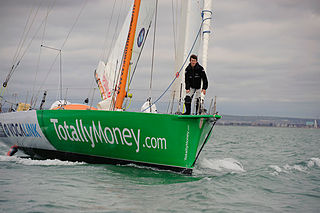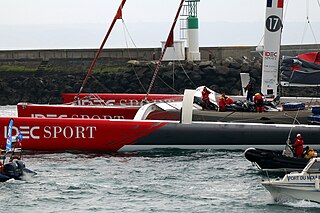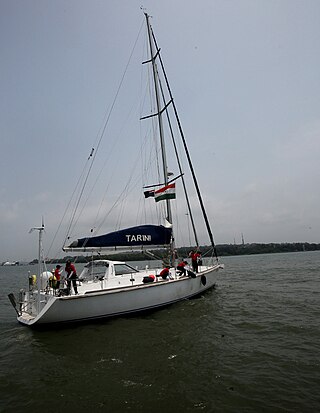
Circumnavigation is the complete navigation around an entire island, continent, or astronomical body. This article focuses on the circumnavigation of Earth.

Sir William Robert Patrick Knox-Johnston is a British sailor. In 1969, he became the first person to perform a single-handed non-stop circumnavigation of the globe. Along with Sir Peter Blake, he won the second Jules Verne Trophy, for which they were also named the ISAF Yachtsman of the Year award. In 2007, at the age of 67, he set a record as the oldest yachtsman to complete a round the world solo voyage in the Velux 5 Oceans Race.

Bernard Moitessier was a French sailor, most notable for his participation in the 1968 Sunday Times Golden Globe Race, the first non-stop, singlehanded, round the world yacht race. With the fastest circumnavigation time towards the end of the race, Moitessier was the likely winner for the fastest voyage, but he elected to continue on to Tahiti and not return to the start line in England, rejecting the idea of the commercialization of long distance sailing. He was a French national born and raised in Vietnam, then part of French Indochina.
The sport and practice of single-handed sailing or solo sailing is sailing with only one crewmember. The term usually refers to ocean and long-distance sailing and is used in competitive sailing and among cruisers.

The Royal Bombay Yacht Club (RBYC) is one of the premier gentlemen's clubs which was founded in 1846 in Colaba, an area of Mumbai in India. The building was designed by John Adams, who also designed the nearby Royal Alfred Sailors' Homes, and was completed in 1896.

INS Tarangini is a three-masted barque, commissioned in 1997 as a sail training ship for the Indian Navy. She is square rigged on the fore and main masts and fore-and-aft rigged on the mizzen mast. She was constructed in Goa to a design by the British naval architect Colin Mudie, and launched on 1 December 1995. In 2003–04, she became the first Indian naval ship to circumnavigate the globe.

Michael Perham is an English sailor and adventurer from Potters Bar. In 2007 at the age of 14 he became the youngest person in the world to successfully sail across the Atlantic Ocean single-handedly, beating the record set in 2003 by British sailor Seb Clover. In 2009 at the age of 17 he became the youngest person to sail around the world solo. Perham's second record surpassed that of Zac Sunderland, an older 17-year-old American, set only six weeks earlier. Following this, Perham's adventures included driving around the world and racing in many offshore races, most notably the Sydney to Hobart yacht race in 2011 where his team placed second in class.
Hal Roth was an American sailor and author. In 1971 he was awarded the Blue Water Medal of the Cruising Club of America. He died of lung cancer.

The first around the world sailing record for circumnavigation of the world can be attributed to the surviving crew of Ferdinand Magellan's expedition, including the last captain Juan Sebastián Elcano who completed their journey in 1522.

MS Tûranor PlanetSolar, known under the project name PlanetSolar, founded by the Swiss explorer Raphaël Domjan, is the largest solar-powered boat in the world and launched on 31 March 2010. The vessel was designed and engineered by LOMOcean Marine. In May 2012, the vessel became the first solar electric vehicle ever to circumnavigate the globe taking 584 days between 2010 and 2012.
Solo is an Australian ex-ocean racing yacht, winning over 80 races during her eight-year racing career, all on the east coast of Australia. Solo has circumnavigated the world three times, circumnavigated Australia twice and was charted for two Antarctic expeditions. All of these achievements plus many more have earned her the title "The lady of the sea".

Trishna is a Swan 37 yacht belonging to the Corps of Engineers of the Indian Army. The name Trishna means “to thirst for” in the Sanskrit language. The 1970-vintage boat, earlier known as Guinevere of Sussex, was purchased in 1984 from the United Kingdom. The yacht has since been used for long distance ocean sailing and training. The first of the yachts' journeys after it was acquired was its voyage from Gosport to Mumbai, India. Subsequently, the yacht embarked on its most notable voyage, the circumnavigation of the globe from 1985 to 1987. This was the first such achievement by an Indian crew. In subsequent years, the yacht has been used for international cruises primarily in the Indian Ocean region. The Yacht currently is decommissioned and is standing as an exhibit at the College of Military Engineering, Pune.

INSV Mhadei is a sail training boat of the Indian Navy. On 19 May 2010 as he sailed Mhadei into Mumbai harbour, Commander Dilip Donde became the first Indian national to complete a single-handed circumnavigation under sail, in an Indian-built boat. He sailed from Mumbai on 19 August 2009 and returned to Mumbai after four stops on 19 May 2010. It was later used by Abhilash Tomy for his own single-handed, unassisted, non-stop circumnavigation under sail.

Keith White was a British yachtsman. In October 2015 he set out on a non-stop solo circumnavigation of the world in his yacht, the Marathon, in part to raise funds for charity. White, who was disabled, lost the use of his left arm in 1991 due to a road traffic accident. A sailor since he was 16 years old, he achieved some significant firsts with his circumnavigation of the UK and Ireland, and his circuit of the Atlantic.

INSV Tarini is the second sailboat of the Indian Navy. She was constructed at Aquarius Shipyard located in Goa. After undergoing extensive sea trials, she was commissioned to Indian Navy service on 18 February 2017.

The Mhadei class are ocean going sail training boats of the Indian Navy & include INSV Mhadei and INSV Tarini as the 2 sail boats of the class. On 19 May 2010 as he sailed Mhadei into Mumbai harbour, Commander Dilip Donde became the first Indian national to complete a single-handed circumnavigation under sail, in an Indian-built boat. He sailed from Mumbai on 19 August 2009 and returned to Mumbai after four stops on 19 May 2010. It was later used by Abhilash Tomy for his own single-handed, unassisted, non-stop circumnavigation under sail.

Navika Sagar Parikrama was a circumnavigation of the globe by female officers of the Indian Navy. The six-member all-woman team circumnavigated and managed the whole operation in their first-ever global journey, on INSV Tarini. The voyage lasted 254 days, from 10 September 2017 to 21 May 2018, with only 4 port calls, in Fremantle, Australia; Lyttelton, New Zealand; Port Stanley, Falkland Islands; and Cape Town, South Africa, and a forced technical halt at Port Louis, Mauritius, crossing the equator twice and passing through 3 oceans. The voyage was originally set to start on September 5, 2017, but a 5-day delay happened so that Nirmala Sitharaman, who was recently appointed defense minister, could flag off the crew. The boat returned to INS Mandovi in Goa after travelling 21,600 nautical miles. The voyage was showcased in Tarini, a documentary jointly produced by National Geographic and the Indian Navy, premiering at an event at Lady Shri Ram College on 8 March to mark International Women's Day. The voyage prompted National Geographic to start the "Girls Who Sailed" campaign, to tell tales of "grit and determination".

Commander Abhilash Tomy, KC, NM (Retd) is a retired Indian Navy officer, naval aviator and yachtsman. In 2013, he became the first Indian to complete a solo, non-stop circumnavigation of the world under sail. He also competed in the 2018 Golden Globe Race. In January 2021, he retired from military service to concentrate on the 2022 Golden Globe Race. He finished second in the race, becoming the only Asian skipper to win a podium finish in a round the world race.

Captain Dilip Donde is a retired Indian Naval officer and the first Indian to complete a solo, unassisted circumnavigation of the globe under sail. From April 2006 to May 2010 he planned and executed Project 'Sagar Parikrama' which involved constructing a sailboat in India and then sailing it around the world. He was the hundred and ninetieth person to complete the journey solo.

























